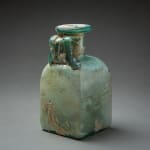Square Glass Juglet, 200 CE - 500 CE
Mould-blown Glass
14.7 x 7.6 cm
5 3/4 x 3 in
5 3/4 x 3 in
LO.945
Light bluish juglet featuring a tall square body with slightly concave base, slightly sunken shoulder, cylindrical neck with ledged rim folded inward. A wide handle ribbed lengthwise rising vertically from...
Light bluish juglet featuring a tall square body with slightly concave base, slightly sunken shoulder, cylindrical neck with ledged rim folded inward. A wide handle ribbed lengthwise rising vertically from the shoulder attached to the upper part of the neck. The surface showing cloudiness, weathering and iridescence.
Despite their relative fragility, glass containers were produced for the transport and storage of liquids from very early on. Such vessels have thick walls, convenient handles, their bodies are usually cylindrical or square. The handles do not protrude beyond the walls, making it possible to pack and store the jugs tightly. Square vessels such as this one could be packed and stored with an even greater economy of space than the cylindrical ones. These were either blown in moulds or free-blown, the body shaped on the marver by flattening.
Though it is normally assumed that this type of jars served mainly for the transport and storage of liquids, since they were considered quality containers in their right own, often were they reused even in funerary contexts, especially in western Europe.
For a comparable example see: Y. Israel, Ancient Glass in the Israel Museum, 2003: pl. 327, p. 255.
Despite their relative fragility, glass containers were produced for the transport and storage of liquids from very early on. Such vessels have thick walls, convenient handles, their bodies are usually cylindrical or square. The handles do not protrude beyond the walls, making it possible to pack and store the jugs tightly. Square vessels such as this one could be packed and stored with an even greater economy of space than the cylindrical ones. These were either blown in moulds or free-blown, the body shaped on the marver by flattening.
Though it is normally assumed that this type of jars served mainly for the transport and storage of liquids, since they were considered quality containers in their right own, often were they reused even in funerary contexts, especially in western Europe.
For a comparable example see: Y. Israel, Ancient Glass in the Israel Museum, 2003: pl. 327, p. 255.



